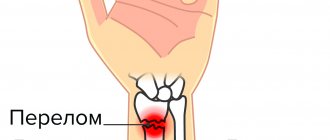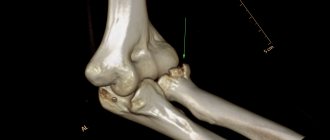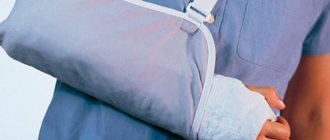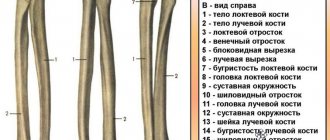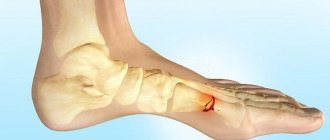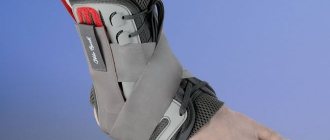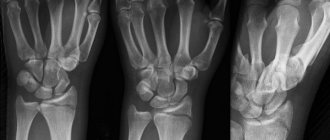Some patients need rehabilitation after a fracture of the radius - this is a set of measures that is carried out to quickly heal the injury site. Recovery includes several stages; in the early period, complete immobilization of the limb under the supervision of an orthopedic surgeon is indicated. When a callus forms, the cast is removed, and the program includes measures to restore function and self-care to the patient. A visit to a sanatorium or rehabilitation in Greece will help you consolidate all basic skills.
Simplified classification of radial fractures in a typical location
Depending on the mechanism of injury, fractures are:
Flexion or Smith's fracture. With such a fracture, the point of impact falls on the dorsum of the wrist and the distal radius is displaced towards the palmar side.
Extensor or Koless fracture. With such an injury, the point of impact falls on the palm and, as a rule, bone fragments are displaced to the back. There is good blood circulation in the distal part of the radius, so with any fractures the bone heals quite quickly. Therefore, timely elimination of the displacement is necessary, otherwise the bone will heal in the wrong position.
In addition to these two main types, fractures can be open or closed. With open fractures, the integrity of the skin is compromised. With comminuted fractures, the integrity of the bone is disrupted in several places at once, as a result of which it turns out to be split into 3 or more parts.
The basic principles of treatment for a fracture of the distal radius are closed reduction (elimination of displacement) of the damaged parts and ensuring immobility of the hand, which is achieved by applying a fixing plaster cast or open reduction and installation of a plate and screws. After wearing a cast for a long time or after surgery, almost all patients experience partial atrophy of muscle tissue and a decrease in the range of motion of the joints.
Recovery Features
The radius bone of the upper limb has its own characteristics - it is thin and rather fragile. If you injure your hand or fall during icy conditions, it is easy to damage the integrity of the radius bone. An attempt to prevent a fall and instinctively putting the arm forward with the palm resting leads to a fracture, because the strength of the bone is not enough. Patients with calcium deficiency develop complex comminuted fractures.
One can only imagine the extent of recovery that awaits patients after a fracture of the radius. It will not be possible to return to normal life in a few days - the appearance of the hand, and one’s own feelings present a sad picture:
- the skin of the hand acquires a bluish tint due to injury to small blood vessels;
- due to limited blood flow to the hand, numbness and stiffness are felt when trying to make the slightest movements with the hand;
- the first movements are awkward and accompanied by painful sensations;
- noticeable visual shortening of the limb.
REFERENCE! To restore hand function, it is necessary to go through a rehabilitation stage, which lasts from two weeks to one and a half months.
Work on an injured arm occurs at home; at the clinic, doctors recommend certain exercises to patients and show basic movements to develop the arm. The surgeon will prescribe a massage, which will be performed exclusively by a clinic specialist.
Rehabilitation after a fracture is considered successful if the person was able to restore the functions of the limb that existed before the injury. This is extremely important for people whose profession involves special skills and abilities (for example, violinists).
Rehabilitation of the wrist joint after plaster immobilization
To restore the functionality of the hand, you need to begin a rehabilitation program even before removing the plaster cast.
Rehabilitation of the wrist joint after a fracture consists of the following procedures:
- Therapeutic physical education, exercises for which are developed by a rehabilitation doctor on an individual basis depending on the type of fracture.
- A massage that lasts about 30 days and helps restore muscles.
- Development of joints.
After removing the plaster cast, physical treatment is indicated: electrophoresis, mud therapy, magnetic therapy, UV irradiation, electrical stimulation, etc.
When completing a course of physiotherapy, swelling subsides, pain goes away, bone callus is finally formed, oxygen supply to the damaged area and its blood supply improves. In addition to physical therapy, the doctor may prescribe other procedures to help restore bone tissue. These can be warm compresses, paraffin therapy, acupuncture, baths with various herbs that promote rapid healing of damaged tissues.
Hand development includes massage
How to quickly recover an arm after a fracture? To do this, it is important to pay attention not only to physical exercise, but also to massage. It allows you to stretch stiff muscles and restore impaired blood flow. This will enhance the transfer of oxygen to muscle fibers, which will significantly improve their condition.
Warm muscles will be more responsive to exercise. This will improve the effectiveness of rehabilitation measures.
In addition, massage can be used without reference to gymnastics, for example, in the morning and evening. It is better to use a massage ball or rings for this. They are easy and pleasant to work with.
We hope that our article has given you enough information on how to develop an arm after a fracture. Take care of yourself and always be in good shape!
A set of exercises at the stage of immobilization in a cast
When the cast allows you to move your fingers, you can do the following exercises:
- Bend and straighten unfixed fingers.
- Connect your thumb with the rest of your fingers.
- Using a healthy hand, bend the nail phalanx of the injured hand.
Exercises should not cause discomfort or pain; if they occur, you should provide complete rest to your hand and, after a while, start exercising again.
If pain or tissue swelling does not go away, you should immediately consult your doctor.
How to help the victim
If a fracture is suspected, it is important to provide timely assistance to the victim to prevent unnecessary movement. It is as follows:
- fix the injured arm with sticks or a splint;
- in case of an open wound, treat it with antiseptics;
- Apply a cold compress to the sore spot and keep it for at least 20 minutes;
- prohibit the victim from getting up and moving forward; it is important that he does not make unnecessary movements or become a coward with his sore arm.
From a painful shock, people can run, grab their hand with force at the site of injury, or shake it. This only makes things worse. It is better to explain that the injury is severe and small fragments from unnecessary movements can cause even greater harm and complicate treatment. If you have painkillers on hand, offer the victim to take one or two tablets. The usual analgin and no-spa are ineffective in such a situation, but on a subconscious level they will calm the person a little.
Development of the wrist joint after plaster removal
During this period, you need to perform exercises to restore range of motion, increase the strength of previously immobilized muscles, and the mobility of ligaments.
Helps increase muscle strength - flexion and extension of the hand. For this purpose, you can use a foam sponge; after a certain period, you should increase the load and instead of a sponge, work out with some rubber object. It could be an expander.
Tendon exercises
The patient stands straight, arm raised up, palm open. The metacarpophalangeal joint bends into a duck's bill, a hook, then a fist.
Resistance Exercises
For this exercise you will need an elastic bandage. The patient sits down on the table sideways, resting his forearm on the surface of the table, with his hand down. One end of the bandage is fixed on the foot, the other is in the lowered hand. The wrist is flexed and extended.
Exercise on the simulator
If there is no special simulator for developing a hand, then you can replace it with a manual sewing machine. The patient sits down at the machine, presses his elbow to his body and begins to rotate the handle of the machine away from himself, then towards himself.
Restoration of basic functions
Aching pain in the arm from shoulder to hand
At the initial stage of recovery, it is enough to perform the most basic movements that allow you to be serviced in everyday life. To do this, doctors recommend starting recovery with
- exercises:
- Take a small rubber ball in your hand, which fits comfortably into your palm. The ball needs to be squeezed several times and slowly, and then increase the number of repetitions to 15-20, performing them more rhythmically;
- squeezing your palm without a ball is an effective exercise for training an injured limb. In this case, you need to clench your hand into a fist and squeeze your fingers with force;
- Since after a long stay in a cast, fine motor skills of the hands also suffer, patients are advised to be sure to develop their fingers. You need to take a piece of plasticine or an anti-stress toy and actively knead it in your hands. At first, your hand will get very tired and even ache, but later it will become easier to control your fingers. Perform the exercise for 5-10 minutes a day, and also knead the object in any free time;
- sitting at the table, put your palms together in a “praying” position, and tilt your hand to one side, and with the other palm create resistance against the tilt of your hand. There should be no discomfort; when performing the exercise, the tension in the arm muscles is actively felt;
- to develop the sensitivity of the hand, which is lost after a long stay in a cast, it is necessary to twist a rubber ball with spikes in the palm;
- it is useful to throw balls against the wall and catch them with your hands - this simple exercise perfectly restores the dexterity of the hand that the patient had before the injury;
- if the victim is female, then she most likely knows how to knit - this is a great way to have a good time and restore a limb after a fracture of the radius bone of the arm. At first, knitting will become an impossible task, and your hands will not obey, but over time, developing the limb will bear fruit.
All of these exercises will perfectly restore the primary performance of the limb if performed daily and in sufficient volume. Don’t be alarmed if your hands get tired, because this is a natural state after prolonged immobilization of a limb, and gymnastics only helps restore health to your hand.
Doctors also emphasize that not only physical therapy exercises for fractures, but also daily household activities play a big role in restoring a damaged limb. It is enough for the hands to “switch on” muscle memory and remember what the person often did before the injury. Therefore, doctors advise rotating the limb in different directions more often, using it to get objects from the top shelves, putting small objects in a box, combing hair - all these actions further involve the limb in the usual process.
Nutrition during the rehabilitation period after radiation surgery
It is very important that during the rehabilitation period after a fracture, the patient’s body receives a sufficient amount of vitamins and minerals, namely calcium, phosphorus, fluorine, silicon, ascorbic and nicotinic acid, vitamins A, E, B, D. After all, they are necessary for the formation of new bone fabrics.
For a speedy recovery, doctors advise sticking to a dairy-vegetable diet, eating as much fish, cottage cheese, greens, nuts and bran bread as possible.
The duration of rehabilitation of the wrist joint is individual in each case and depends on the type of fracture, the age of the victim, and concomitant diseases.
| To the list of articles | Rehabilitation of hand joints |
Treatment
A professional traumatologist will quickly determine the presence of a fracture and its nature. But for a more accurate diagnosis, an x-ray of the bone is taken. Based on the image, it is easier for the doctor to assemble the broken bone and join the fragments. Sometimes this is done using special equipment. Everything is done under local anesthesia. After completion, a plaster cast, splint or tight bandage is applied.
It is possible to make the correction manually. Even a highly qualified doctor does not make it possible to do this without special equipment. In severe cases, needles or fixation devices are used. If the fracture occurs without displacement, then it is treated with plaster.
Returning functionality
Keeping the arm in a fixed state for a long time, especially with a complex fracture with a displacement, has an extremely negative effect on its tissues. Because of this, a disruption occurs in the functioning of the nerve endings, and the functioning of the hand becomes difficult. It is no coincidence that after removing the plaster, the following changes can often be observed:
- bluish skin;
- significant limitation in mobility;
- pain when moving your hand;
- visual shortening of the injured limb in comparison with a healthy one.
It is impossible to immediately return to the normal rhythm of life after the cast is removed, and some more time is needed to develop the limb. The period lasts up to four weeks and may require not only exercise therapy, but also physical therapy.
To speed up the recovery process, your doctor may prescribe the following measures:
- rubbing;
- massage;
- exercise therapy;
- physiotherapy.
The main thing for the patient is not to violate medical recommendations, not to miss sessions and not to overload the sore arm. If you exercise a limb too intensively, this will not speed up the restoration of its functioning, but, on the contrary, will aggravate the situation and delay recovery.
Use of medications
To facilitate the massage, massage oil is applied to the skin. At the same time, the massage therapist’s hand glides better and does not injure the patient’s skin. Essential oils of coniferous trees (fir, pine, cedar, eucalyptus, turpentine) are added to the massage oil.
Oils have a local irritant effect, increase blood flow, improve microcirculation and metabolism in tissues, stimulate recovery, and also have antibacterial and anti-inflammatory effects. Oils of coniferous trees, especially fir, were used in folk medicine for closed injuries, fractures, and joint pain.
Among medications, ointments and gels from the group of non-steroidal anti-inflammatory drugs are widely used. These are diclofenac, ibuprofen, naproxen, ketoprofen and others. They have anti-inflammatory, analgesic and anti-edematous effects.
Other external agents have a more pronounced anti-edematous effect: troxevasin, indovazin, lyoton, venoruton, venolife and others. This group contains substances that strengthen the walls of blood vessels, reducing the permeability of veins and capillaries. Due to this, elimination of swelling, a cooling and analgesic effect are observed.
There is a group of products that contains bee venom, snake venom, red pepper tincture, collagen and biologically active components. They have a warming effect. They are used during a period when there is no longer significant tissue swelling, active inflammatory process or skin damage. Their action is aimed at improving nutrition and accelerating tissue recovery.



